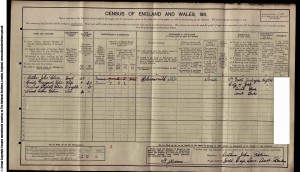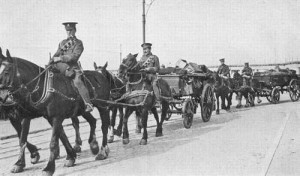Arthur John Robbins. Died 29th April 1915
Arthur was born in 1877 in St Neotts, Huntingdonshire to father John and mother Sarah. He had eight siblings, four brothers and four sisters. By the age of 26 he had married Emily Dawson, with whom he had three children; Margaret, Ernest and Louisa. By 1911, Arthur had become a Blacksmith; the family living in Gold Cup Lane, Ascot, Berkshire. Although we cannot be sure, we know Emily was a servant in a large house in 1901 and probably met whilst he was carrying out his duties as a blacksmith. The couple could then have been moved to the centre of the horse racing and trading industry in Ascot. His parents meanwhile continued to live in Huntingdonshire.
Arthur joined the Army Service Corps, Meerut Division HQ in August 1914. He was 5 feet 8½ inches tall, brown hair, blue eyes and a scar on his finger. He was 35 years old and describes his work as a Farrier. As a result of this equine skill he is immediately recruited to the Army Service Corps and he is given the position of Corporal. It is not hard to understand why he was so eagerly snapped up by the ASC. The British Army stood at 120,000 men and 53,000 horses in August 1914. By November, that number had risen to 3 million men and 500,000 horses requiring over 30,000,000 tons of feed.
On April 20th 1915, Arthur had been struck down with strychnine poisoning and nine days later he had died. He was buried at Souchez, near Bethune in France, the location which, in the following year was to be at the centre of the Battle of the Somme.
After the war, Emily moved back up to Yorkshire where she had been brought up; there was no further need to live in Ascot and in probability she would not have been able to stay in the same estate provided abode. The service records tell us Emily then had problems proving her pension was that of a corporal’s widow and not a private’s. All records showed Arthur as a Corporal even though her local pensions office denied this. We do not know of the outcome. At the same time as this altercation took place, Emily also received thanks from the state in the form of a belated 1914 Star medal, a memorial scroll and a letter from the King. The pension records are a strange collection of correspondence, fretting over lost papers, demands for duplicates, letters from various departments to Emily repeating the record of Arthur’s death. The records show the bureaucracy ambling along without a clue of the carnage that would engulf them in the following months.
The question mark hangs over Arthur’s death when we ask how he could have been poisoned by strychnine and given the pallid response that it was just an accident. There is no record of any report into the exact cicumstances of his death, when it would have been quite possible to do so, unlike that of a battlefield fatality.
There is still no single antidote other than absorption of that which remains undigested. The attack is painful and swift being fatal within a few hours.
Name: ROBINS, ARTHUR JOHN
Rank: Corporal
Regiment/Service: Army Service Corps
Unit Text: Meerut Div. H.Q.
Age: 36
Date of Death: 29/04/1915
Service No: MS/3038
Additional information: Son of John Robins, of St. Neots, Hunts; husband of Emily Margaret Robins, of 4, Wharfe View Terrace, Ilkley, Yorks.
Grave/Memorial Reference: XVII. B. 2.Cemetery: CABARET-ROUGE BRITISH CEMETERY, SOUCHEZ
4, Wharfe View Terrace, Ilkley, Yorks. (1911)
Gold Cup Lane, Ascot, Berkshire (Emily post war)



